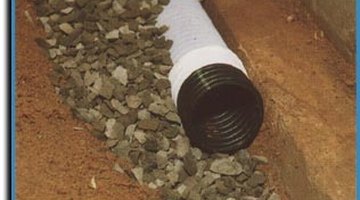How to Install Footing Drains
Footing drains, also known as drain tile, are imperative in areas where the ground saturates during any time of the year, particularly if the home sits on a basement. The easiest time to install footing drains is during the construction of the home.

Things You Will Need
- Drain tile
- 18-inch PVC pipe
- 2 PVC T-adapters
- 1-inch rocks
- Sand
- Pipe lid
- Sump pump
- Excavator (existing foundation )
However, installing them later is imperative if water enters the basement or constant concrete seepage is an issue. The actual installation of the footing drains is relatively simple.
-
Seal the concrete before installing footing drains on a new basement. Depending upon your city’s building code, it may be a requirement. After cleaning away loose dirt, roll foundation sealant on the walls and the footing.
-
Measure the perimeter of your basement, leaving a few feet of extra space for the drain tile.
-
Purchase the drain tile. Drain tile sells by the linear foot and customer service personnel will cut the exact length for you. If you have a walkout basement, you may subtract that portion of the wall from your measurement. In addition, with a walkout, there is no need for a sump pump or the PVC pipe.
-
Install an 18-inch PVC pipe that will hold your sump pump in the bottom of a window well of an egress window. Alternately, install the pipe outside your foundation. Place the pipe at least 3 feet lower than the footing. Cut holes in the pipe and install PVC T-adapters on either side at the same level as your footing.
-
Attach one end of the drain tile to a T-adapter in PVC pipe and run the drain tile in one continuous line, on top of the footing, all the way around the foundation. Make sure it is as close as possible to the foundation by bracing it with a brick or a rock every few feet. The end of the drain tile will attach to the other T-adapter after circling the foundation.
-
Alter the ends of the drain tile by beginning along the footing on one side of the walkout and ending on the other side. In this case, allow a few feet to extend on both sides.
-
Cover the drain tile with 1-inch rocks to a depth of at least 1 foot all the way around the footing. This provides a layer of protection to keep the drain tile perforations from clogging. In areas where clay soil is a problem, add an additional 1 to 3 feet of sand before backfilling.
-
Connect the sump pump and lower it into the PVC pipe, leaving a rope or pipe extending above for easy retrieval should the pump need servicing. Place the exterior pipe in an area where it will drain along the soil grade away from the house. The exterior drain attaches just under the lid of the 18-inch pipe and angles outwards to the surface.
-
Place a cap on the PVC pipe and cover with rocks if it is in the window well. If it is outside, cover it with the cap and either backfill with a little soil, or cover it with a rock bed. Avoid placing anything permanent over the lid.
-
Trim the ends of the drain tile on a walkout basement and place a drain cover on each side to allow the water to drain out. It’s important to cover the ends immediately to prevent mice or other rodents from entering the pipe and nesting.
Tip
Install footing drains around new basements. It's much easier to do it now than to re-dig it later.
Tips
- Install footing drains around new basements. It's much easier to do it now than to re-dig it later.
Writer Bio
Glenda Taylor is a contractor and a full-time writer specializing in construction writing. She also enjoys writing business and finance, food and drink and pet-related articles. Her education includes marketing and a bachelor's degree in journalism from the University of Kansas.
Photo Credits
- Royalty free image.
- Royalty free image.
More Articles



